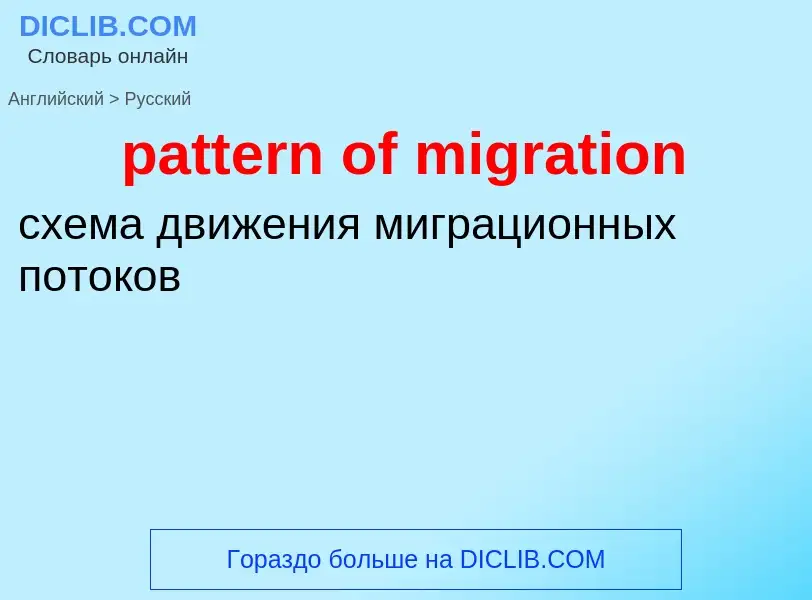Перевод и анализ слов искусственным интеллектом ChatGPT
На этой странице Вы можете получить подробный анализ слова или словосочетания, произведенный с помощью лучшей на сегодняшний день технологии искусственного интеллекта:
- как употребляется слово
- частота употребления
- используется оно чаще в устной или письменной речи
- варианты перевода слова
- примеры употребления (несколько фраз с переводом)
- этимология
pattern of migration - перевод на русский
[i'rʌpʃ(ə)n]
общая лексика
вторжение
набег
нашествие (напр. саранчи)
существительное
общая лексика
вторжение
разлитие
разлив
взрыв
демографический взрыв
внезапное вторжение, набег, нашествие
общая лексика
перелётная птица
общая лексика
перенос [миграция] данных
процесс физического перемещения данных из одной среды в другую. Это требуется, если данные переносятся на другую аппаратную платформу или другую СУБД
в ЭВМ с иерархической системой памяти - перемещение редко используемых данных на устройства с более медленным доступом
['pætnrekəg'niʃ(ə)n]
общая лексика
распознавание образов
идентификация графических изображений с помощью компьютерных технологий. Используется, в биометрических методах контроля доступа для распознавания голоса, отпечатков пальцев, фотографий и. п
Определение
.
Википедия

Animal migration is the relatively long-distance movement of individual animals, usually on a seasonal basis. It is the most common form of migration in ecology. It is found in all major animal groups, including birds, mammals, fish, reptiles, amphibians, insects, and crustaceans. The cause of migration may be local climate, local availability of food, the season of the year or for mating.
To be counted as a true migration, and not just a local dispersal or irruption, the movement of the animals should be an annual or seasonal occurrence, or a major habitat change as part of their life. An annual event could include Northern Hemisphere birds migrating south for the winter, or wildebeest migrating annually for seasonal grazing. A major habitat change could include young Atlantic salmon or sea lamprey leaving the river of their birth when they have reached a few inches in size. Some traditional forms of human migration fit this pattern.
Migrations can be studied using traditional identification tags such as bird rings, or tracked directly with electronic tracking devices. Before animal migration was understood, folklore explanations were formulated for the appearance and disappearance of some species, such as that barnacle geese grew from goose barnacles.


.jpg?width=200)
![High-mountain [[shepherd]]s in [[Lesotho]] practice [[transhumance]] with their flocks. High-mountain [[shepherd]]s in [[Lesotho]] practice [[transhumance]] with their flocks.](https://commons.wikimedia.org/wiki/Special:FilePath/High mountain Shepherds.jpg?width=200)
![spawn]] spawn]]](https://commons.wikimedia.org/wiki/Special:FilePath/Jumping Salmon.jpg?width=200)
![monarch]], tagged for identification monarch]], tagged for identification](https://commons.wikimedia.org/wiki/Special:FilePath/Monarch Butterfly Danaus plexippus Tagged Closeup 3008px.jpg?width=200)
![An aggregation of migratory ''[[Pantala flavescens]]'' dragonflies, known as globe skimmers, in [[Coorg]], India An aggregation of migratory ''[[Pantala flavescens]]'' dragonflies, known as globe skimmers, in [[Coorg]], India](https://commons.wikimedia.org/wiki/Special:FilePath/PantalaFlavescensTalakaveri.jpg?width=200)
![barnacle geese]] during autumn migration barnacle geese]] during autumn migration](https://commons.wikimedia.org/wiki/Special:FilePath/BrantaLeucopsisMigration.jpg?width=200)
![Grus grus]]) gather in the northern federal states of Germany, [[Mecklenburg-Vorpommern]] and [[Brandenburg]] to rest and prepare for the long journey to the south. Grus grus]]) gather in the northern federal states of Germany, [[Mecklenburg-Vorpommern]] and [[Brandenburg]] to rest and prepare for the long journey to the south.](https://commons.wikimedia.org/wiki/Special:FilePath/Flock of cranes feeding on harvested fields in Northern Germany (I).jpg?width=200)
![[[Ruby-throated hummingbird]] [[Ruby-throated hummingbird]]](https://commons.wikimedia.org/wiki/Special:FilePath/Rubythroathummer65.jpg?width=200)


.jpg?width=200)
![Fitting a nettle/canvas-fabric on a [[dress form]] Fitting a nettle/canvas-fabric on a [[dress form]]](https://commons.wikimedia.org/wiki/Special:FilePath/Fitting muslin dummy.jpg?width=200)
.jpg?width=200)



![tailor's tack]] with thread to mark a pattern on fabric before cutting the fabric tailor's tack]] with thread to mark a pattern on fabric before cutting the fabric](https://commons.wikimedia.org/wiki/Special:FilePath/Basting pattern markings.jpg?width=200)

![The face was automatically detected]] by special software. The face was automatically detected]] by special software.](https://commons.wikimedia.org/wiki/Special:FilePath/800px-Cool Kids of Death Off Festival p 146-face selected.jpg?width=200)
